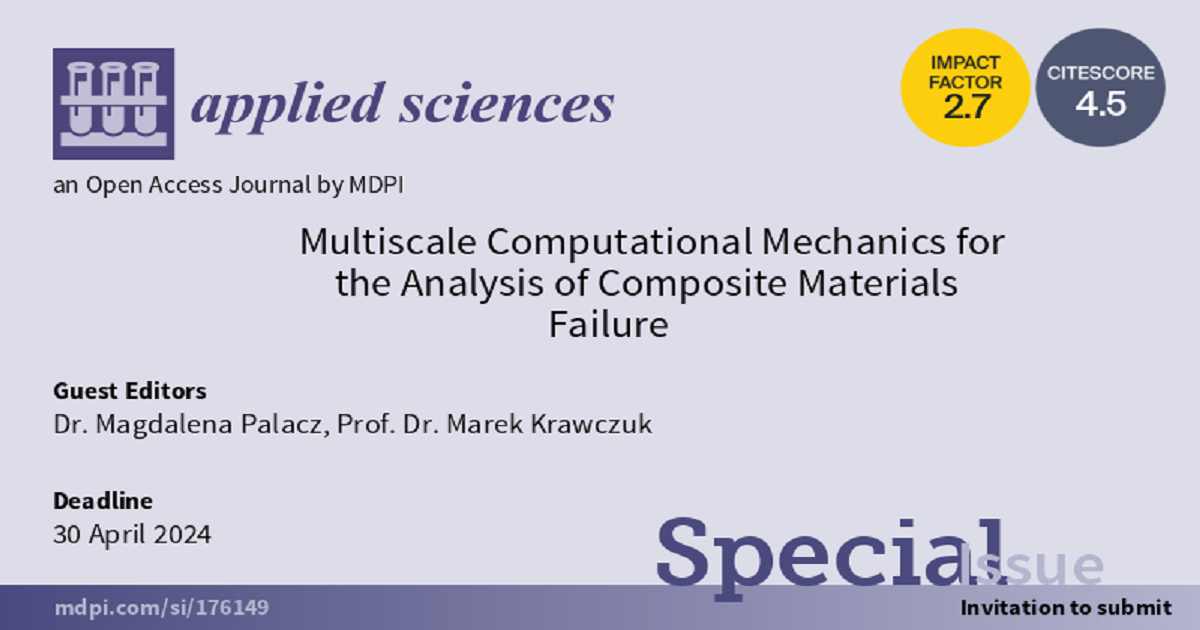Multiscale Computational Mechanics for the Analysis of Composite Materials Failure
A special issue of Applied Sciences (ISSN 2076-3417). This special issue belongs to the section "Materials Science and Engineering".
Deadline for manuscript submissions: closed (30 April 2024) | Viewed by 1566

Special Issue Editors
Interests: sensing technologies; numerical modeling; damage detection; wave propagation; energy harvesting
Special Issues, Collections and Topics in MDPI journals
Interests: finite element modeling; numerical modeling; signal processing; numerical analysis; structural analysis; finite element analysis
Special Issues, Collections and Topics in MDPI journals
Special Issue Information
Dear Colleagues,
Industries in modern societies are increasingly involved in responsible consumption and production. Innovative technologies are driving interest in utilizing composite materials, as these types of materials feature interesting sets of properties. Those properties may be analyzed using computational modelling, especially in terms of failure mechanisms in them.
Composite materials are materials made up of different components combined to achieve specific properties. Understanding how and why these materials fail is crucial for engineering applications and has been one of the main interests of various research groups for several decades. From another point of view, the term "multiscale" indicates that the analysis is conducted at various levels, from the microscopic scale (e.g., individual fibers and their interactions) to the macroscopic scale (e.g., overall structural behavior). By employing computational techniques, researchers can simulate and study the behavior of composite materials under different loading conditions and identify the factors contributing to their failure. This multiscale approach helps in uncovering the underlying mechanisms that lead to failure, guiding the development of improved composite materials and design strategies.
In summary, the proposed Special Issue should bridge the gap between the world of computational mechanics, with a focus on multiple scales and investigation of the failure behavior of composite materials. It aims to enhance the understanding of composite material failure and provide that information allowing the development of more durable and efficient composite structures to wider audience of scientific world.
Dr. Magdalena Palacz
Prof. Dr. Marek Krawczuk
Guest Editors
Manuscript Submission Information
Manuscripts should be submitted online at www.mdpi.com by registering and logging in to this website. Once you are registered, click here to go to the submission form. Manuscripts can be submitted until the deadline. All submissions that pass pre-check are peer-reviewed. Accepted papers will be published continuously in the journal (as soon as accepted) and will be listed together on the special issue website. Research articles, review articles as well as short communications are invited. For planned papers, a title and short abstract (about 100 words) can be sent to the Editorial Office for announcement on this website.
Submitted manuscripts should not have been published previously, nor be under consideration for publication elsewhere (except conference proceedings papers). All manuscripts are thoroughly refereed through a single-blind peer-review process. A guide for authors and other relevant information for submission of manuscripts is available on the Instructions for Authors page. Applied Sciences is an international peer-reviewed open access semimonthly journal published by MDPI.
Please visit the Instructions for Authors page before submitting a manuscript. The Article Processing Charge (APC) for publication in this open access journal is 2400 CHF (Swiss Francs). Submitted papers should be well formatted and use good English. Authors may use MDPI's English editing service prior to publication or during author revisions.
Keywords
- composite materials failure
- multiscale modelling
- numerical analysis
Benefits of Publishing in a Special Issue
- Ease of navigation: Grouping papers by topic helps scholars navigate broad scope journals more efficiently.
- Greater discoverability: Special Issues support the reach and impact of scientific research. Articles in Special Issues are more discoverable and cited more frequently.
- Expansion of research network: Special Issues facilitate connections among authors, fostering scientific collaborations.
- External promotion: Articles in Special Issues are often promoted through the journal's social media, increasing their visibility.
- e-Book format: Special Issues with more than 10 articles can be published as dedicated e-books, ensuring wide and rapid dissemination.
Further information on MDPI's Special Issue policies can be found here.






